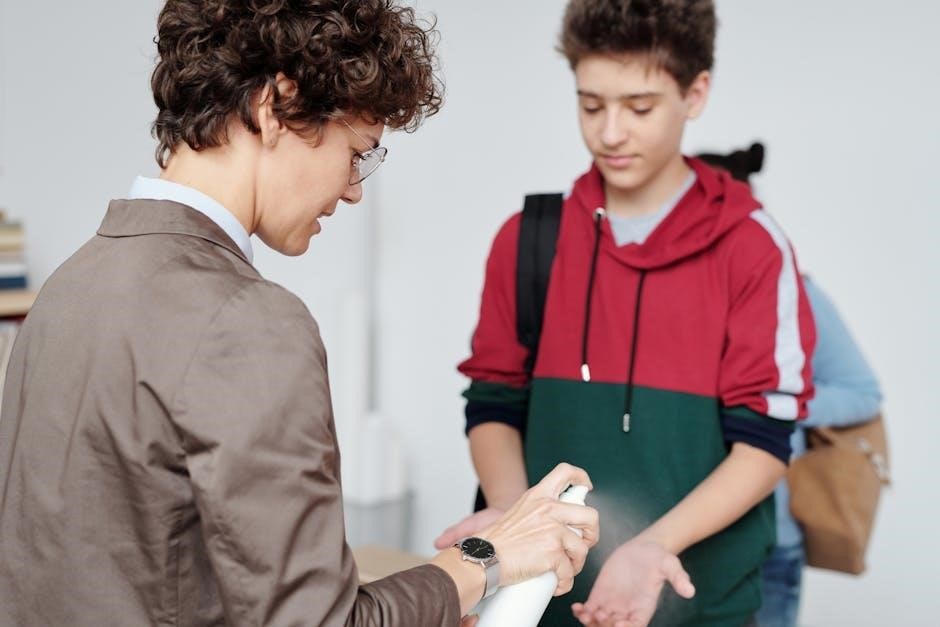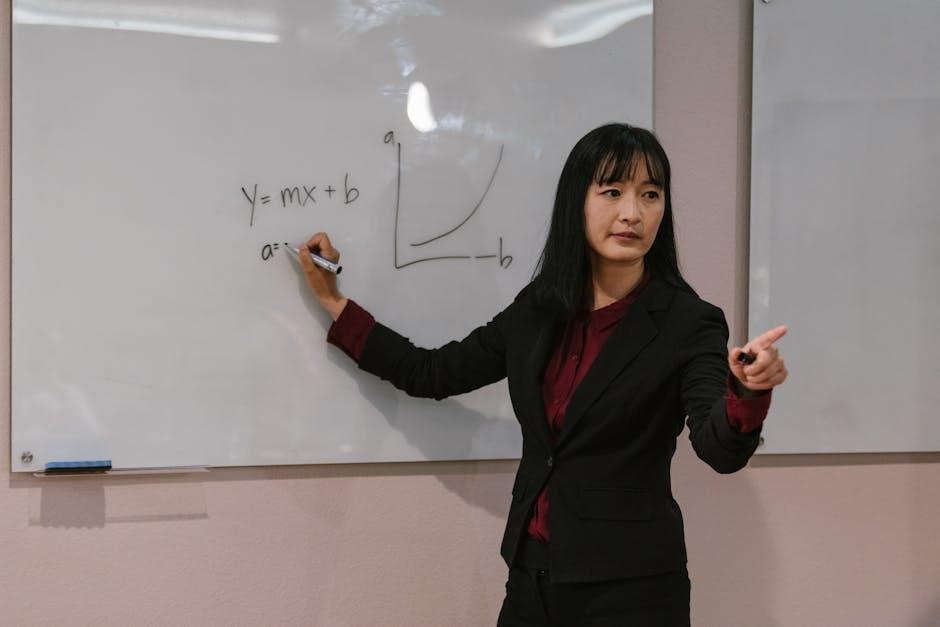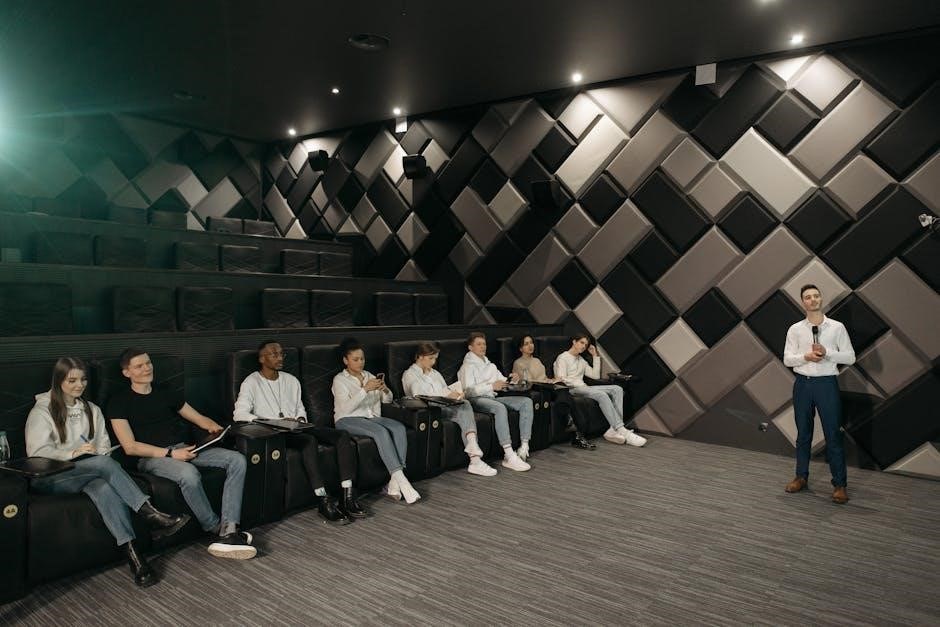
A Parent-Teacher Conference Form is a document used to record discussions between parents and teachers‚ outlining a student’s strengths‚ concerns‚ and action plans. Available in PDF and Word formats‚ it facilitates effective communication and planning‚ ensuring clarity and organization during meetings.
1.1 What is a Parent-Teacher Conference Form?
A Parent-Teacher Conference Form is a structured document used to record discussions between parents‚ teachers‚ and sometimes students. It outlines a student’s strengths‚ concerns‚ and action plans‚ serving as a formal record of the meeting. Available in PDF and Word formats‚ it provides a clear framework for communication‚ ensuring all key points are addressed and documented effectively.
1.2 Purpose of the Form
The purpose of a Parent-Teacher Conference Form is to create a structured record of discussions‚ ensuring clear communication between parents and teachers. It documents a student’s strengths‚ concerns‚ and action plans‚ providing a reference for future meetings. The form also helps track progress and involves parents in their child’s education‚ fostering collaboration and accountability for student growth and development.
Importance of Parent-Teacher Conference Forms
Parent-Teacher Conference Forms are essential for documenting meetings‚ outlining student strengths‚ concerns‚ and action plans. They serve as a reference for future tracking and involve parents in their child’s education‚ promoting collaboration and accountability for student growth.
2.1 Benefits for Teachers
Parent-Teacher Conference Forms provide teachers with a structured approach to document student progress‚ concerns‚ and action plans. They help organize thoughts‚ facilitate clear communication‚ and ensure accountability. The forms serve as a reference for future meetings‚ aiding in tracking student growth and maintaining consistency in feedback. This tool supports teachers in setting clear goals and collaborating effectively with parents‚ fostering a cohesive educational environment focused on student success.
2.2 Benefits for Parents
Parent-Teacher Conference Forms empower parents by providing a clear record of their child’s progress‚ strengths‚ and areas for improvement. They enable parents to track developmental milestones and stay informed about their child’s educational journey. The forms also ensure that parental concerns and suggestions are documented and addressed‚ fostering collaboration with teachers. This transparency and organization help parents feel more involved and confident in their child’s education‚ leading to better outcomes and stronger home-school partnerships.
2.3 Benefits for Students
Parent-Teacher Conference Forms provide students with a clear understanding of their strengths and areas for improvement. They enable students to set specific goals and track progress over time. The forms also encourage student involvement in their education‚ fostering a sense of responsibility and ownership. By documenting achievements and challenges‚ the forms help students stay motivated and focused on their academic and personal growth‚ promoting overall success and development.

Types of Parent-Teacher Conference Forms
Parent-Teacher Conference Forms are available in traditional paper-based formats and digital PDF versions‚ offering flexibility for documentation and ease of use during meetings and planning.
3.1 Traditional Paper-Based Forms
Traditional paper-based forms are physical documents used to record parent-teacher conference details. They are often printed and filled out by hand‚ providing a tangible record of discussions. These forms are ideal for face-to-face meetings‚ offering a straightforward and personal approach to documenting student progress‚ concerns‚ and action plans. Many schools prefer them for their simplicity and ease of use during in-person conversations‚ ensuring clarity and organization in communication.
3.2 Digital and PDF Forms
Digital and PDF forms offer a modern‚ efficient alternative to traditional paper-based methods. These formats are easily editable‚ allowing teachers to customize and save changes. PDF forms are particularly popular due to their compatibility across devices and the ability to print them when needed. They streamline the process of documenting meetings‚ making it simpler to track student progress and share information with parents. This method also reduces paper waste and enhances organization.
Preparing for a Parent-Teacher Conference
Preparation involves organizing materials‚ reviewing student progress‚ and setting a clear agenda. Teachers and parents should gather relevant documents to ensure productive discussions.
4.1 Teacher Preparation
Teachers should gather all necessary documents‚ such as progress reports‚ grades‚ and samples of student work. Reviewing individual student needs and preparing notes ensures focused discussions. Organizing a structured agenda helps address key topics efficiently. Anticipating questions and maintaining a positive‚ solution-oriented tone fosters collaboration. Preparation enables teachers to provide clear insights and recommendations‚ ensuring productive conversations with parents.
4.2 Parent Preparation
Parents should review their child’s progress reports and identify questions or concerns. Gathering materials like homework samples or behavior notes can provide insights. Reflecting on their child’s strengths and challenges helps guide discussions. Parents should also consider goals and any specific issues to address. Arriving prepared with a collaborative mindset ensures productive conversations and supports their child’s success.

Conducting an Effective Parent-Teacher Conference
Creating a positive environment‚ fostering collaboration‚ discussing progress‚ setting goals‚ and ensuring understanding between parents and teachers are key to effective conferences.
5.1 Setting the Tone for the Meeting
Begin by creating a welcoming atmosphere‚ ensuring both parties feel comfortable and valued. Start with positive feedback about the student to build rapport. Use a structured agenda to guide the discussion‚ ensuring clarity and focus. Encourage open dialogue by actively listening and maintaining a non-judgmental tone. This approach fosters collaboration and sets a productive foundation for the conference.
5.2 Active Listening and Communication
Active listening involves fully engaging with the speaker‚ maintaining eye contact‚ and showing empathy. Clear communication ensures ideas are expressed effectively. Parents and teachers should ask questions and provide constructive feedback‚ fostering mutual understanding and collaboration. This approach helps address concerns and align on student support strategies. Non-verbal cues like nodding can show engagement‚ ensuring the student’s needs remain the focus.
5.3 Discussing Student Progress and Goals
Detailed discussion of a student’s progress involves reviewing academic performance‚ strengths‚ and areas needing improvement. Setting specific‚ measurable goals ensures clarity and direction. Teachers and parents collaborate to create actionable plans‚ fostering student growth. Open dialogue about expectations and resources helps align efforts‚ ensuring the student receives comprehensive support to achieve their objectives successfully.

Follow-Up After the Conference
Effective follow-up involves monitoring progress‚ maintaining communication‚ and providing feedback to ensure students meet their goals. Regular updates and adjustments to plans support continued growth and success.
6.1 Creating a Plan of Action
A clear plan of action outlines specific steps to support student progress. Teachers and parents collaborate to set measurable goals‚ assign responsibilities‚ and establish timelines. This plan ensures alignment with the student’s needs and provides a roadmap for follow-through. Regular check-ins and feedback loops are essential to track progress and make adjustments as needed.
6.2 Monitoring Student Progress
Monitoring student progress ensures the plan’s effectiveness and tracks growth over time. Teachers regularly assess performance‚ using metrics like grades‚ assignments‚ and behavior. Parents receive updates‚ fostering collaboration and timely interventions. Adjustments to the plan are made based on data‚ ensuring the student stays on track to meet goals and achieve success.
Using PDF Templates for Parent-Teacher Conferences
Using PDF templates for parent-teacher conferences streamlines communication‚ ensuring consistency and professionalism. They provide a structured format‚ making it easier to organize and share essential student information efficiently.
7.1 Advantages of PDF Formats
PDF formats offer universal compatibility‚ ensuring accessibility across devices and platforms. They maintain consistent formatting‚ preserving the professional appearance of parent-teacher conference forms. PDFs are easily shareable via email or online platforms‚ making distribution efficient. Additionally‚ they can be password-protected for security and edited to customize content‚ catering to specific needs while maintaining a professional standard.
PDFs are also eco-friendly‚ reducing the need for paper. Their versatility allows for easy archiving and retrieval‚ making them a practical choice for schools and parents. Overall‚ PDF formats enhance the efficiency and organization of parent-teacher conference forms.
7.2 Customizing PDF Templates
Customizing PDF templates allows schools to tailor parent-teacher conference forms to their specific needs. Users can add school logos‚ modify fields‚ and include relevant sections. This ensures the form aligns with the school’s branding and policies. Additionally‚ customization enhances clarity and professionalism‚ making the forms more user-friendly for both teachers and parents. It also allows for the inclusion of specific data or questions relevant to individual students or meetings.
Editing software‚ such as Adobe Acrobat‚ enables easy modifications. Schools can adapt templates to suit different grade levels or special requirements. This flexibility ensures the forms remain effective tools for fostering communication and collaboration. Customization also helps in creating a consistent and organized format‚ which is essential for maintaining professionalism and clarity in parent-teacher conferences.

Legal and Privacy Considerations
Legal and privacy considerations are crucial for parent-teacher conference forms. Schools must comply with regulations like FERPA to protect student data and ensure confidentiality. This builds trust and accountability.
8.1 Ensuring Confidentiality
Ensuring confidentiality is vital when handling parent-teacher conference forms. Schools must implement secure storage methods‚ both physical and digital‚ to protect sensitive student and family information. Access should be restricted to authorized personnel only. Digital forms should use encryption and secure portals to prevent unauthorized access. Training staff on data protection and privacy laws‚ such as FERPA‚ is essential to maintain trust and legal compliance;
8.2 Compliance with School Policies
Compliance with school policies is essential when using parent-teacher conference forms. Schools must ensure that all forms align with district and institutional guidelines‚ including data collection and sharing practices. Proper training for staff on policy adherence is crucial. Using standardized PDF templates helps maintain consistency and ensures that all legal and procedural requirements are met‚ promoting accountability and professionalism in parent-teacher interactions.

Cultural and Language Considerations
Cultural differences and language barriers can impact parent-teacher conferences. Schools must respect diverse backgrounds and ensure clear communication. Providing translated materials and interpreters supports non-English speakers‚ fostering inclusivity and effective collaboration.
9.1 Communicating Across Different Cultures
Effective communication across cultures requires understanding and respect for diverse traditions and values. Teachers should be culturally sensitive‚ avoiding assumptions and using clear‚ inclusive language. Non-verbal cues‚ such as body language and tone‚ also play a significant role in building trust with parents from varied backgrounds.
Active listening and adaptability are key to fostering meaningful dialogue. By acknowledging cultural differences‚ educators can create a welcoming environment for open discussion‚ ensuring all voices are heard and valued during the conference.
9.2 Providing Translations for Non-English Speakers
Providing translations for non-English speakers ensures accessibility and understanding during parent-teacher conferences. Schools can offer translated PDF forms or interpretation services to bridge language gaps.
This fosters equal participation and ensures all parents can engage fully in discussions about their child’s progress and needs.

Involving Students in the Conference
Involving students encourages active participation and accountability‚ fostering a collaborative environment where their voice is valued‚ enhancing the conference’s effectiveness and promoting ownership of their learning journey.
10.1 Student-Led Conferences
Student-led conferences empower students to take ownership of their learning by leading discussions about their progress. This approach fosters confidence‚ communication skills‚ and accountability. Students prepare by gathering work samples‚ reflecting on strengths and challenges‚ and setting goals. During the conference‚ they present this information to parents and teachers‚ ensuring their voice is central to the conversation. This method aligns with educational goals focused on student involvement and self-advocacy.
10.2 Encouraging Student Reflection
Encouraging student reflection helps them think critically about their learning and progress. Guided questions prompt students to identify strengths‚ challenges‚ and goals. Reflective practices‚ such as journaling or self-assessment‚ foster accountability and self-awareness. Incorporating reflection into parent-teacher conference forms allows students to articulate their thoughts‚ making the process more student-centered and meaningful. This practice nurtures a growth mindset and enhances overall educational development.

Best Practices for Filling Out the Form
Best practices include ensuring clarity‚ accuracy‚ and organization. Use clear language‚ avoid jargon‚ and organize information logically. Double-check for errors and ensure all sections are complete for effective communication.
11.1 Being Specific and Objective
When filling out the form‚ focus on providing specific‚ factual information about the student’s performance and behavior. Avoid vague statements by using concrete examples and data. Objectivity ensures fairness and clarity‚ fostering a collaborative environment. Clearly state observations‚ such as academic progress or areas needing improvement‚ to guide discussions. This approach helps parents and teachers align on goals and strategies for student success.
11.2 Focusing on Solutions and Growth
When completing the form‚ emphasize actionable solutions and student growth opportunities. Highlight strengths to build confidence‚ then address challenges with specific strategies for improvement. For example‚ suggest extra tutoring or homework adjustments. This approach fosters collaboration and ensures both teachers and parents are aligned on goals. Focus on progress monitoring and adapting strategies as needed for continuous development.

Common Challenges and Solutions
Common challenges include communication gaps‚ time constraints‚ and differing perspectives. Solutions involve active listening‚ clear agendas‚ and collaborative problem-solving to ensure productive outcomes for all parties.
12.1 Overcoming Communication Barriers
Communication barriers‚ such as language differences or emotional sensitivities‚ can hinder effective conferences. Using translation services‚ preparing materials in advance‚ and fostering a respectful‚ open dialogue help bridge gaps. Teachers should remain empathetic and ensure all parties feel heard‚ creating a safe space for collaboration and mutual understanding to support student success.
12.2 Managing Time Effectively
Effective time management is crucial for productive conferences. Teachers should create a structured agenda‚ set time limits for discussions‚ and prioritize key topics. Parents should also prepare questions in advance. Using a timer or visual schedule can help keep the conversation focused‚ ensuring all important points are addressed without rushing or extending beyond the allocated time.

The Future of Parent-Teacher Conference Forms
The future of parent-teacher conference forms lies in enhanced digital integration‚ offering real-time collaboration and personalized templates to streamline communication and support individual student needs effectively.
13.1 Integration with Technology
The future of parent-teacher conference forms involves seamless integration with technology‚ such as digital tools and online platforms‚ to enhance accessibility and efficiency. PDF formats can be easily shared‚ edited‚ and stored digitally‚ reducing paperwork. Schools can adopt cloud-based systems for real-time collaboration‚ enabling parents and teachers to access and update forms conveniently. This shift promotes better organization and faster communication‚ ensuring all parties stay informed and aligned.
13.2 Personalized Forms for Individual Needs
Personalized parent-teacher conference forms cater to individual student needs‚ ensuring tailored discussions. PDF templates can be customized to include specific sections for IEPs‚ learning styles‚ or behavioral goals. This approach allows teachers and parents to focus on unique challenges and strengths‚ fostering more meaningful and targeted conversations. Personalization enhances collaboration and supports student-specific outcomes effectively.
Effective parent-teacher communication is vital for student success. PDF forms streamline conferences‚ ensuring organized and productive discussions. They foster collaboration‚ supporting student growth and academic achievement.
14.1 Recap of Key Points
Parent-teacher conference forms‚ especially in PDF format‚ are essential tools for fostering effective communication. They provide structured frameworks for discussing student progress‚ identifying challenges‚ and setting goals. These forms benefit teachers‚ parents‚ and students by promoting collaboration‚ accountability‚ and personalized learning strategies. Regular follow-ups ensure consistent support‚ making PDF forms a valuable resource for enhancing educational outcomes and student success.
14.2 Final Thoughts on Effective Communication
Effective communication is the cornerstone of successful parent-teacher conferences. By fostering open dialogue‚ collaboration‚ and mutual understanding‚ educators and parents can work together to support student growth. Trust‚ active listening‚ and clear goals are essential for meaningful conversations. Maintaining this connection ensures continued support for students‚ fostering their academic and personal development. Open communication is key to unlocking their full potential.